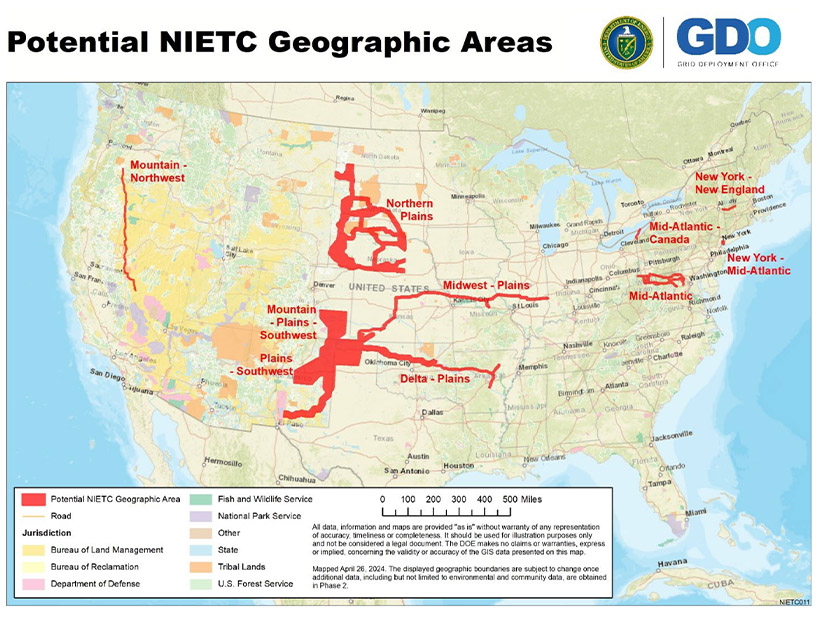
FERC acted on rehearing requests for Order 1977 on Oct. 17, finalizing the rules it will follow under limited backstop siting authority for transmission lines.
The major change FERC made to the original proposal, which was approved this year alongside Order 1920 on transmission planning, was to require projects seeking rights of way on Tribal lands to include their proposals in Tribal engagement plans. Developers will have to describe how they will work with Tribal landowners on right-of-way issues.
“We at FERC are focused on Tribal engagement,” FERC Chairman Willie Phillips said in a statement. “It is important that project sponsors work closely with Tribal landowners on these right-of-way issues as part of their overall engagement with Tribes on transmission matters.”
The order lays out how FERC will handle backstop siting applications in National Interest Electricity Transmission Corridors. They were established by the Energy Policy Act of 2005, but for much of that time, the authority was hobbled by a court decision. Congress updated the law in 2021 to say FERC could overrule a state that denies a transmission line’s application that would go through NIETC if approved by the Department of Energy.
DOE announced preliminary NIETCs this spring a few days before FERC’s initial order but has yet to finalize corridors where the commission’s backstop siting authority could be used. (See On the Road to NIETCs, DOE Issues Preliminary List of 10 Tx Corridors.)
The new rule includes a Landowner Bill of Rights, codifies an Applicant Code of Conduct as a way for applicants to show good faith engagement with landowners and directs applicants to develop engagement plants for outreach to environmental justice communities and Tribes.
The New York PSC filed for rehearing, arguing FERC should be able to step in only a year after a complete application has been filed with a state regulator. FERC agreed a final application is an important consideration for the process but declined to include the requirement the PSC sought.
The pre-filing process requires developers to inform FERC of the status of any state applications and allows state regulators to raise issues around their review when any application is being debated before the federal regulator. The commission will look at issues case by case, the rehearing order said.
The Louisiana PSC asked that FERC give deference to state decisions and presume they are correct, with the burden of proof on developers to overcome state decisions. FERC said it would take the state decisions into account but that they are not determinative under the law.
“If the commission finds that the statutory criteria under section 216(b) have been met, it may issue a permit to construct or modify electric transmission facilities in a national corridor notwithstanding a state’s denial of the same,” FERC said. “The commission’s consideration, as described in the final rule, of whether an application meets the statutory criteria for commission jurisdiction does not improperly intrude upon state authority.”
A group of public interest organizations argued that FERC should automatically include all of a state docket’s information as it reviews a line for backstop siting. FERC rejected that request, saying while it will consider relevant information from state proceedings, some of the filings could be irrelevant to the federal process.
The public interest groups argued the lack of automatic filing could set a procedural trap to keep relevant information out of the FERC proceeding, noting the start of a pre-filing process and the filing of an actual application with the commission are intended to encourage stakeholder participation and disseminate information about the case. Applicants must make a good faith effort to notify “any known individuals or organizations that have expressed an interest in the state siting proceeding,” the order said.
The Pennsylvania PUC wanted rehearing on the Landowner Bill of Rights, arguing that states should be able to help develop such documents and the current version ignores state siting authority, which could misinform landowners.
FERC said having multiple versions of the Landowner Bill of Rights could lead to confusion and inefficiencies.
“Requiring applicants to provide affected landowners with a copy of the Landowner Bill of Rights — a generic document developed by the commission and intended to provide information about the federal permitting process in a broad and consistent manner — does not preclude an applicant from providing additional information to landowners about additional rights under state law or ongoing state siting proceedings, if applicable,” FERC said.


